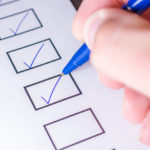Every time you visit your doctor or healthcare provider, someone takes your blood pressure. Taking your blood pressure is the only way to know if you have high blood pressure (also called hypertension). Nearly half of American adults have high blood pressure, and many don’t know it. Treating and managing high blood pressure is important.
Blood pressure readings include two numbers. The top number is the systolic pressure (the force of blood on the artery walls when your heart beats) and the bottom is the diastolic pressure (the force of blood on the artery walls while your heart’s resting between beats).
Healthy vs. Unhealthy Numbers
Here are important blood pressure numbers from the American Heart Association:
- Normal blood pressure is less than 120/less than 80
- Elevated blood pressure is 120-129/less than 80
- High blood pressure (hypertension stage 1) is 130-139/80-89
- High blood pressure (hypertension stage 2) is 140 or higher/90 or higher
- Hypertension crisis (consult your doctor immediately) is higher than 180/higher than 120.
Your doctor may have a different blood pressure target for you based on your age and personal health issues.
If your blood pressure is normal, keep doing what you’re doing (follow a balanced diet and get regular exercise).
If your blood pressure is elevated and you aren’t proactively trying to control it, you’ll most likely develop high blood pressure over time.
If you have high blood pressure (hypertension stage 1 and 2), your doctor is most likely treating it with medications (or a combo of medications) and strongly encouraging lifestyle changes.
If your blood pressure is suddenly above 180/120, wait five minutes, test it again and if it’s still high, call your doctor immediately.
If your blood pressure is 180/120 and you’re having chest pain, shortness of breath, back pain, numbness/weakness, change in vision or speech, call 911 immediately.
Symptoms of High Blood Pressure
Despite what a lot of people think, high, even dangerously high blood pressure often causes no symptoms. That’s why it’s called a silent killer. While high blood pressure usually has no symptoms, it does increase your risk for heart attack, stroke, heart failure, kidney disease or failure, vision loss, sexual dysfunction, angina, or peripheral artery disease. The higher your blood pressure and the longer it stays that way untreated, the more your risk increases.
Fact vs. Fiction
People make a lot of assumptions about high blood pressure. Here are a few facts:
- Even if high blood pressure runs in your family, you can avoid it yourself with proper lifestyle choices (balanced diet, regular exercise).
- Even if you don’t use table salt, that doesn’t mean you’re controlling your sodium intake (sodium can increase blood pressure). Read labels — most processed foods contain a lot of sodium.
- All salts are created equal when it comes to sodium content. Using kosher or sea salt rather than table salt doesn’t make a difference.
- Just because you feel fine, that doesn’t mean you are fine (remember, silent killer). Get your blood pressure checked.
- Your provider checks your blood pressure, but you should also monitor it at home. Home monitoring readings can help your doctor assess your treatment plan.
- Not all blood pressure medications cause terrible side effects. We have come a long way with medications, and most people on blood pressure medication today are not bothered by side effects. In fact, some people state they feel better on the medication.
8 Things You Can Do About High Blood Pressure
- Eat a well-balanced, low-sodium diet (less than 2300 mg a day).
- Follow your treatment plan; see your doctor regularly and take your medications as prescribed.
- Learn how to check your blood pressure at home.
- Stay at a healthy weight. This is especially important if you put on weight around your waist. If you are overweight, losing even 10 pounds can help you lower your blood pressure.
- Try to do moderate aerobic activity at least 2½ hours a week. Or try to do vigorous activity at least 1¼ hours a week. Be sure to check with your provider before starting an exercise program.
- If you drink alcohol, drink moderately. Limit alcohol to two drinks a day for men and one drink a day for women.
- Try to limit the amount of sodium you eat to less than 2300 mg a day. Follow the DASH (Dietary Approaches to Stop Hypertension) eating plan. This plan can help you lower blood pressure. Its focus is on fruits, vegetables, healthy fats, and low-fat dairy foods. This type of eating plan can help you lose weight and lower your risk for heart disease.
- Don’t smoke. Smoking increases your risk for heart attack and stroke. If you need help quitting, talk to your doctor about stop-smoking programs and medicines. These can increase your chances of quitting for good.
This article was edited by Dr. Beth Hodges, a family practice and palliative care/hospice physician in Asheboro, N.C., and part-time medical director for HealthTeam Advantage.






